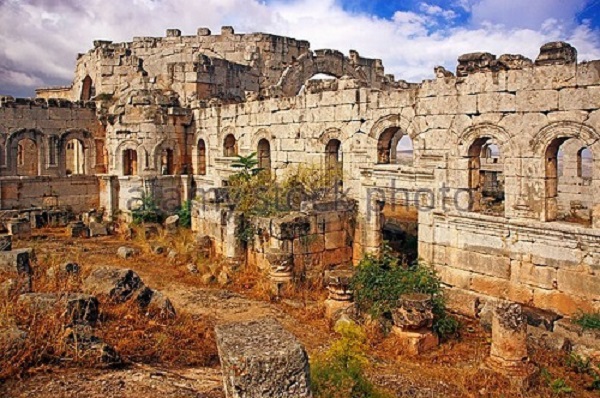ST SIMEON’S CITADEL A MONUMENT CHARACTERIZING SYRIAN ARCHITECTURE THROUGH AGES
Six kilometers North West ofAleppo, over a protruding rockycliff surrounded by valleys in thenorth, south and east, forming naturaldefensive lines, perches St. SimeonCitadel, considered one of the wondersof local architecture. The citadelreflects the influence of Byzantine andclassical arts on Syrian art of building.
This influence is represented by slimcolumns topped with decorated capitalswhich seem as if they are leaning with the wind, and also by the beautifuloctagon decorated with symmetricalsides and curves based on wonderfulpieces of art. Colors of the stonematch the surrounding colors ofnature. Porticos, gates, and windows seem as if they are open to the wind.
High walls stand erect in a proudencounter with time and the incursionsof human beings. This monumentenflames imagination of travelerswho pass in front of it as if theywere crossing centuries of silence intotimes bustling with vividness, art, andprosperity.
The name of this citadel was always coupledwith one of the most famous easternmonks; Simeon the Stylite (392-459AD) who secluded himself from peopleand preferred to live in full asceticismand austerity. He built a hermitage35Km east of Antioch, 60Km northwestof Aleppo at the top of a hill near Mt.Barakat.
In 412AD, over the hill, Simeon built asmall cottage, raised a high pillar,topped it with a seat, and lived on it forover 27 years, day and night, winter andsummer, under conditions of naturalhazards. In spite of this, his followersused to make circles around the pillar tolisten to his teachings, and people camefrom different parts of the country tohear his sermons while he is suspendedbetween the earth and the sky. After Simeon’s death in 459AD, EmperorXenon, in respect to Simeon, built amonastery around the pillar.
In the occasion of his visit to theMonastery of St. Simeon in 590AD, historianEwakrius noted that at the end ofthe fifth century the pillar and its surroundingswere changed into an archedbuilding of eight wings, four of themformed the basilica. Later, architectscouldn’t decide whether the octagonalarched wings were roofed or not.
 The citadel
The citadel
The citadel stands on a rocky hill surroundedby defensive towers. It isunique in terms of design and constructiontechniques, made of four sections inthe form of a basilica (a rectangularshape with columns dividing it intothree porticos). The building had severalpolitical, economical and social functions.
The heart of the citadel is an octagonwith the pillar in the center. It has fourarches open to the main porticos, withfour smaller arches including a capitalbased on a Greek more adjacent arches are open to theside porticos. It is not clear whether thecentral block was roofed, and if so, theceiling was not more than a lightwooden dome so that it may not imposea heavy weight on the walls. This is thedescription of Ewakrius when he visitedthe place.
Each side of the octagon is divided intothree sections in the shape of porticos withtwo lines of columns with the central porticois wider than the other two porticos.
Each of the three western, southern andnorthern sections is 24X25 m, i.e. they aresquare, while the eastern one is 22X24m,and it is a little inclined towards the northbecause it constitutes the center of thecitadel. Each of the three other sections hasa niche at its end, and beside each nichethere are two square rooms, one is specializedfor the clothes of the clergy,Deaconicon, and the second is specializedfor donations offered to the church.
The main wall of the citadel has threeniches, the central one is the largest andhas two lines of windows, where as eachof the two smaller ones has one windowonly. All three niches are decorated withtwo lines of columns. style column. Two
Original local art
The entrance of the citadel was built inthe southern side because the traditionalwestern one was very steep. The façade has several narrow windows withtwisted lines of decorations. Just beforethe gate stands the Nartex, and theentrance has three arched openings similarto the Roman arches of victory, thecentral one is the largest and leads to aportico with four gates leading to thethree main porticos of the gate.
Architects built a semi circular openingabove the lintel of each gate with bothends of the arches based on main wallsabove the lintels.
Walls and facades were decorated withchains of ornaments winding round thewindows to give them a wonderfulshape. These decorations are also executedaround the arches in the centraloctagon and are based on Corinthiancolumns of various shapes, reflectingaccurate sculpture and sublime taste ofdecorations, as if they were built in theclassical Greek era, despite the fact thatthe building is mostly built along localstyle.
In the 10th Century, parts of the octagonand the porticos were covered with coloredstones.
 A window on history
A window on history
The citadel remained in its originalstructure until the seventh century whenIslamic conquests reached Aleppo.Moslems kept the place in the hands ofthe clergy according to the tolerantteachings of Islam and the will of theRashidi Caliph, Omar Ibn alKhattabwho, in his famous will, considered thefirst document promoting the freedomof worship, advised respecting all theclergies and properties of other religions.
The original document is keptnow in the Monastery of St. George nearthe city of Homs. To protect the monument,Moslems built twenty seven towerson the wall, in addition to other separatetowers; most of them weredestroyed later. It is worth mentioning that theCitadel of St. Simeon was one of theforts through which the Byzantinesentered the Levant to fight the king ofAleppo, SaifaddawlaalHamadani,whom they considered, the founder ofan Arab State near their borders. TheByzantine king NagaforPhocas vowedto invade and annihilate this Moslemkingdom which separated him fromthe Holy Land. To achieve his goal he first occupied St. Simeon Citadel for itsstrategic and religious position,restored, fortified, and changed it,from a nearly derelict monastery, intoa strong citadel.
In 986AD King Sa’adaddawla, son ofSaifaddawlaalHamadani, liberated thecitadel from the Byzantines, and in 1017AD the Fatimids tried, for a long time, tocapture and it fell to them after fiercebattles.
Haifaa Mafalani

